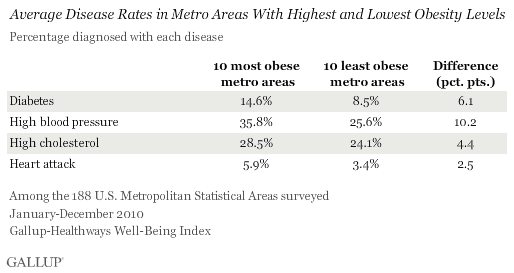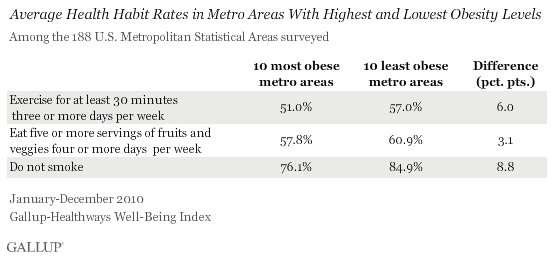WASHINGTON, D.C. -- More than 20% of Americans were obese in 174 of the 188 U.S. metropolitan areas that Gallup and Healthways surveyed in 2010. In the most obese of these metro areas -- Evansville, Ind.-Ky. -- 37.8% of residents were obese, compared with 12.9% in the least obese place -- Boulder, Colo.


Nationwide, 26.6% of American adults were obese in 2010, unchanged from 2009, but higher than 25.5% in 2008. The average obesity rate in the 10 most obese metro areas surveyed in 2010 was 34.1%, compared with 17.4% in the 10 least obese metro areas.
Boulder is the only metro area in the survey to achieve the Centers for Disease Control and Prevention's nationwide goal of lowering obesity rates to 15% by 2010.
Gallup tracks U.S. obesity levels as part of the Gallup-Healthways Well-Being Index, using Americans' self-reported height and weight to calculate Body Mass Index (BMI) scores. BMI scores of 30 or higher are considered obese.
The 2010 metro area findings are extracted from Gallup's 2010 Daily tracking data set of more than 200,000 U.S. adults, aged 18 and older. Gallup categorizes U.S. metro areas according to the U.S. Office of Management and Budget's definitions for Metropolitan Statistical Areas (MSAs), and reports on all MSAs for which there are a minimum of 300 interviews available.
Chronic Conditions More Prevalent in Most Obese Metro Areas
Chronic diseases including diabetes, high blood pressure, and high cholesterol are significantly more prevalent in the 10 most obese metro areas than in the 10 that are the least obese. For example, 14.6% of adults, on average, in the 10 most obese metro areas say they have ever been diagnosed with diabetes, compared with 8.5% in the 10 least obese places.
High blood pressure stands out in particular -- it is 10 percentage points higher in the most obese metro areas than in the least obese ones. More adults also report having had a heart attack in the places where obesity is the highest.

Healthy Habits Less Prevalent in Most Obese Metro Areas
Americans living in the most obese metro areas surveyed are significantly less likely to exercise regularly compared with residents living in the least obese places. They also eat fruits and vegetables slightly less frequently than those in the least obese metro areas.
Additionally, those living in the slimmest metro areas are much more likely to say they do not smoke than are those who live in the most obese places.

Bottom Line
Good health habits have a clear connection to low disease rates and to higher well-being in general. Boulder, the least obese metro area of those surveyed in 2010, also has the highest overall well-being score in the United States. In Boulder, 65.2% of residents say they exercise for at least 30 minutes three or more days per week, more than in any other metro area. Exercise and healthy eating, in addition to helping maintain a healthy weight and prevent certain chronic diseases, have important emotional benefits.
The consequences of high obesity rates for cities come in many forms: higher healthcare costs, lower workplace productivity, and unhappier residents. For cities where more than 3 in 10 residents are obese, these problems are even more pronounced and are even more likely to continue from one generation to the next.
Government and business leaders at the city level are in a unique position to tackle the obesity problem. They are the most familiar with their community's strengths and weaknesses and can use their knowledge to create policies and programs to target efforts to help reduce obesity in their area.
With more than 20% of adults obese in 174 U.S. metro areas and only Boulder meeting the government's goal of 15% obesity rate in 2010, essentially every local leader has a mandate to take significant steps toward reducing obesity.
About the Gallup-Healthways Well-Being Index
The Gallup-Healthways Well-Being Index tracks U.S. well-being and provides best-in-class solutions for a healthier world. To learn more, please visit well-beingindex.com.
Survey Methods
Results are based on telephone interviews conducted as part of the Gallup-Healthways Well-Being Index survey Jan. 2-Dec. 29, 2010, with a random sample of 245,817 adults, aged 18 and older, living in reportable metropolitan statistical areas in all 50 U.S. states and the District of Columbia, selected using random-digit-dial sampling.
Metro areas in this article are based on the Metropolitan Statistical Areas (MSAs) as defined by the U.S. Office of Management and Budget. In many cases, more than one city is included in the same MSA. The San Jose, Calif., MSA, for example, also includes the smaller nearby cities of Sunnyvale and Santa Clara in addition to San Jose itself. Each respondent is attributed to his or her MSA based on the self-report of his or her ZIP code. Gallup reports data for MSAs for which there were at least 300 completed interviews in 2010. A total of 188 MSAs met this criterion, which generally incorporates the larger MSAs according to population size.
Maximum expected error ranges for the MSAs vary according to size, ranging from less than 1 percentage point for the largest cities represented to ±6.5 percentage points for the smallest. Interviews are conducted with respondents on landline telephones (for respondents with a landline telephone) and cellular phones (for respondents who are cell phone only and cell phone mostly).
In addition to sampling error, question wording and practical difficulties in conducting surveys can introduce error or bias into the findings of public opinion polls.
For more details on Gallup's polling methodology, visit https://www.gallup.com/.
